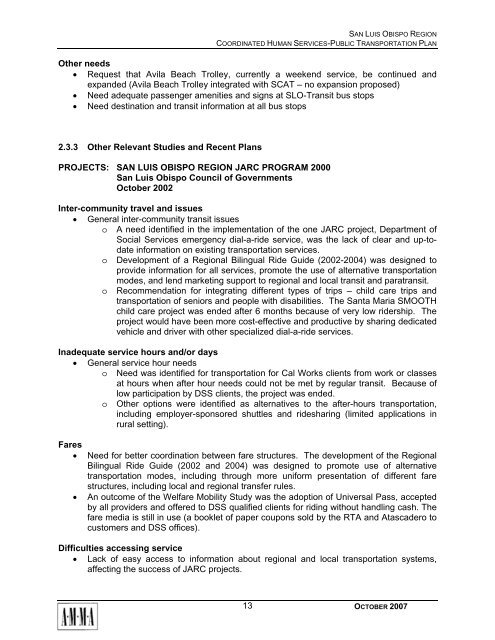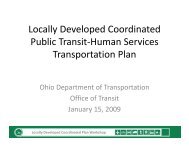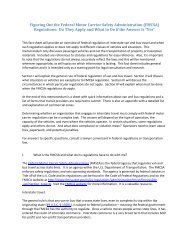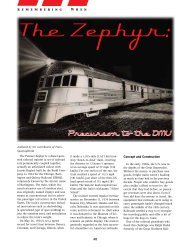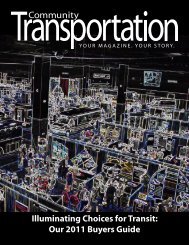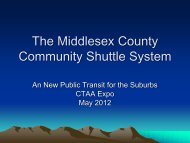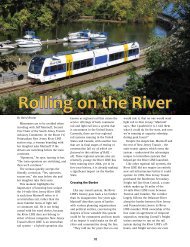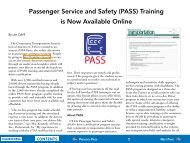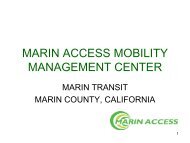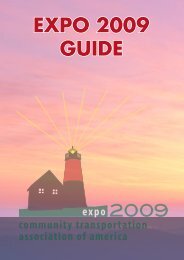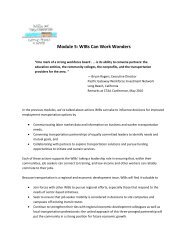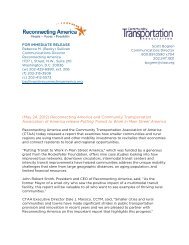San Luis Obispo - Caltrans - State of California
San Luis Obispo - Caltrans - State of California
San Luis Obispo - Caltrans - State of California
You also want an ePaper? Increase the reach of your titles
YUMPU automatically turns print PDFs into web optimized ePapers that Google loves.
SAN LUIS OBISPO REGION<br />
COORDINATED HUMAN SERVICES-PUBLIC TRANSPORTATION PLAN<br />
Other needs<br />
• Request that Avila Beach Trolley, currently a weekend service, be continued and<br />
expanded (Avila Beach Trolley integrated with SCAT – no expansion proposed)<br />
• Need adequate passenger amenities and signs at SLO-Transit bus stops<br />
• Need destination and transit information at all bus stops<br />
2.3.3 Other Relevant Studies and Recent Plans<br />
PROJECTS: SAN LUIS OBISPO REGION JARC PROGRAM 2000<br />
<strong>San</strong> <strong>Luis</strong> <strong>Obispo</strong> Council <strong>of</strong> Governments<br />
October 2002<br />
Inter-community travel and issues<br />
• General inter-community transit issues<br />
o A need identified in the implementation <strong>of</strong> the one JARC project, Department <strong>of</strong><br />
Social Services emergency dial-a-ride service, was the lack <strong>of</strong> clear and up-todate<br />
information on existing transportation services.<br />
o Development <strong>of</strong> a Regional Bilingual Ride Guide (2002-2004) was designed to<br />
provide information for all services, promote the use <strong>of</strong> alternative transportation<br />
modes, and lend marketing support to regional and local transit and paratransit.<br />
o Recommendation for integrating different types <strong>of</strong> trips – child care trips and<br />
transportation <strong>of</strong> seniors and people with disabilities. The <strong>San</strong>ta Maria SMOOTH<br />
child care project was ended after 6 months because <strong>of</strong> very low ridership. The<br />
project would have been more cost-effective and productive by sharing dedicated<br />
vehicle and driver with other specialized dial-a-ride services.<br />
Inadequate service hours and/or days<br />
• General service hour needs<br />
o Need was identified for transportation for Cal Works clients from work or classes<br />
at hours when after hour needs could not be met by regular transit. Because <strong>of</strong><br />
low participation by DSS clients, the project was ended.<br />
o Other options were identified as alternatives to the after-hours transportation,<br />
including employer-sponsored shuttles and ridesharing (limited applications in<br />
rural setting).<br />
Fares<br />
• Need for better coordination between fare structures. The development <strong>of</strong> the Regional<br />
Bilingual Ride Guide (2002 and 2004) was designed to promote use <strong>of</strong> alternative<br />
transportation modes, including through more uniform presentation <strong>of</strong> different fare<br />
structures, including local and regional transfer rules.<br />
• An outcome <strong>of</strong> the Welfare Mobility Study was the adoption <strong>of</strong> Universal Pass, accepted<br />
by all providers and <strong>of</strong>fered to DSS qualified clients for riding without handling cash. The<br />
fare media is still in use (a booklet <strong>of</strong> paper coupons sold by the RTA and Atascadero to<br />
customers and DSS <strong>of</strong>fices).<br />
Difficulties accessing service<br />
• Lack <strong>of</strong> easy access to information about regional and local transportation systems,<br />
affecting the success <strong>of</strong> JARC projects.<br />
13<br />
OCTOBER 2007


